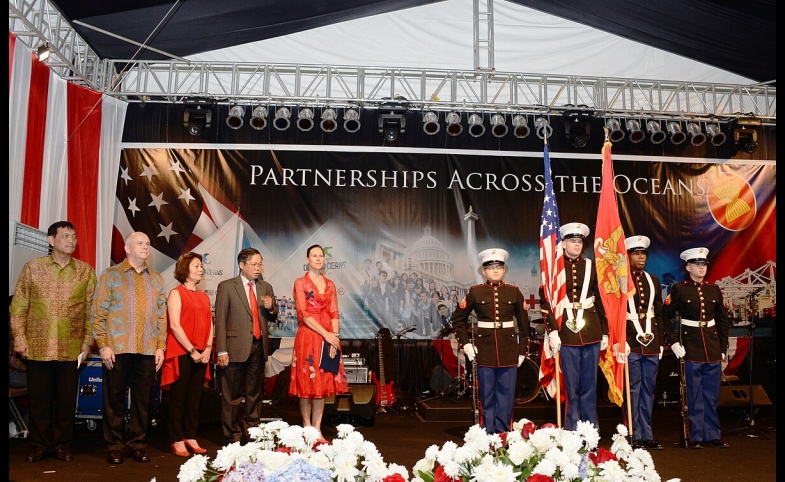I was delighted to read the CPD Blog written by Anja Eifert on Indonesia as an Example of 21st Century Economic Statecraft. It fits well with my research, The Public Diplomacy of Emerging Powers: Insights...
KEEP READINGThe CPD Blog is intended to stimulate dialog among scholars and practitioners from around the world in the public diplomacy sphere. The opinions represented here are the authors' own and do not necessarily reflect CPD's views. For blogger guidelines, click here.

U.S. Public Diplomacy in Indonesia: Redrawing Societal Boundaries to Coincide with Political Borders
After 9/11, Secretary of State Condoleezza Rice’s foreign policy orientation shifted from the realism of power politics to the idealism of what she called “the march of democracy.” Rice argued that at a time of global transformation, American diplomats would need to be active in spreading democracy, reducing poverty, helping failing states pursue stability and development and doing their part to protect the American homeland.
In the years that followed, American public diplomacy initiatives endeavored to transform Indonesia into a more functional, democratic and responsible member of the international community.
The problem in nations with majority Muslim populations, such as Indonesia, is that the non-Islamist agenda is either controlled by a discredited regime or has little organized base in society itself. As a result, the multiplicity of cultural, religious, ethnic and linguistic cleavages does not have a direct or democratic expression in formal political life. The sharpest divide pits Muslims who want to align politics with religion against those who wish to keep these spheres apart.
Brumberg argues that the solution is found less in the realm of ideas than in the support for the quintessentially political process of creating procedures, laws and institutions that ensure the inclusion of all significant groups in government because only a constitutional order that defends everyone’s right to practice or not practice his or her religion freely can secure a polity that is peaceful. The U.S. government, in facilitating the process by effectively leading multiple dialogues and utilizing new global communication technology, can help improve lives and simultaneously craft the American global image.
In short, nations, in their interactions, must understand that cultural identity intervenes to shape state interests.
What about the policy of the Obama Administration? Although the Obama Doctrine was in essence the expression of a strategy of confrontation and concealment, if a threat did not go to the heart of America’s own security, President Obama was more hesitant. He declined to act unless partners with far greater interests at stake took the greatest risks and contributed the greatest resources. President Obama’s policy was more pragmatic than visionary. Seemingly intractable circumstances turned him into a leader focused on repairing relationships and reacting to crises.
As for recent public diplomacy approaches, some observers have suggested the following: (i) adherence to traditional public diplomacy principles; (ii) adaptive and culturally sensitive communications; (iii) comprehensive approach and long-term focus. Other recommendations for improving public diplomacy and strategic communications call for the integration of communications issues within existing strategies for other uses of U.S. national power, including traditional diplomacy, foreign assistance and national defense.
If we critically reflect on Joel Migdal’s view on how state leaders and agencies have been at the center of redrawing societal boundaries to coincide with a state’s political borders, it is obvious that global factors and internal elements of the society may thwart or modify the state’s plan. Swidler makes clear the notion of cultural capacities created in one historical context that can be successfully or unsuccessfully reappropriated or altered in new circumstances.
Also, Jun Honna’s work clearly highlights the reshaping of power elites in three provinces. He specifically examines the changing patterns of civilian politics in three Indonesian provinces. He describes how local elites accommodate the new political contestation in order to maintain their power, and how local military elites take part in the process. He discusses further how local elites orchestrate civic protest by involving preman (hoodlums) to gain politico-economic benefits and how this new aspect of “civic” participation shrinks the space of civil society. He then focuses on the gubernatorial elections and clarifies the significance of civil-military elite collusion.
From 1999 to 2004, the political change that ended three decades of Golkar dominance also modified the pattern of concession hunting among civilian elites. To share in the spoils of government, the territorial military commands mobilized their bargaining power vis-à-vis local leaders. The political elites developed and relied on preman brokers to employ coercion and extortion to help the power elites tap into various concession projects. Group identities were nurtured to undermine the power of civil society organizations, and the patrimonial networks of preman were used to counter the development of class-based horizontal social solidarity vis-à-vis the political elite. Jun Honna argues that the legacy of the past is still influential and shadows democratic consolidation in West, Central and East Java, and structural reform may take some time to happen.
In short, nations, in their interactions, must understand that cultural identity intervenes to shape state interests. Often, an invisible border is needed by elites to keep their conflict of interest hidden from view.
Visit CPD's Online Library
Explore CPD's vast online database featuring the latest books, articles, speeches and information on international organizations dedicated to public diplomacy.
POPULAR ARTICLES
-
March 22
-
April 1
-
April 11
-
March 4
-
April 18
Join the Conversation
Interested in contributing to the CPD Blog? We welcome your posts. Read our guidelines and find out how you can submit blogs and photo essays >.













